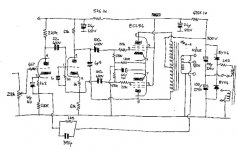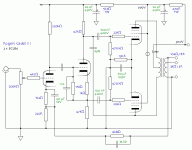ecl84
Hi,
Thanks for all the info.
I listen mostly to headphones so I am not to worried about the wattege of the tube, however I am very pickey about the sound, what would you expect the tube to sound like compare lets say to ecl82 or ecl86 knowing that this tube was developed for video applications.
Thanks.
Glass_painter
Hi,
Thanks for all the info.
I listen mostly to headphones so I am not to worried about the wattege of the tube, however I am very pickey about the sound, what would you expect the tube to sound like compare lets say to ecl82 or ecl86 knowing that this tube was developed for video applications.
Thanks.
Glass_painter
ECL84
Hi,
If you know that the ECL86 is 1/2 ECC83 +one EL84 in a single envelope and you know what those can sound like than that's one out of three eliminated.
One or two other members have developed and built an amp around the ECL82 recently and seemed absolutely pleased with the results.
You can do a search locally for 6BM8/ECL82
I remember this valve to be popular in Holland back in the fifties so somewhere there must have been audio amps using this valve.
The fact that its' primary design goals were targeted at video/TV applications wouldn't stop me from trying it out.
Cheers,
Hi,
what would you expect the tube to sound like compare lets say to ecl82 or ecl86 knowing that this tube was developed for video applications.
If you know that the ECL86 is 1/2 ECC83 +one EL84 in a single envelope and you know what those can sound like than that's one out of three eliminated.
One or two other members have developed and built an amp around the ECL82 recently and seemed absolutely pleased with the results.
You can do a search locally for 6BM8/ECL82
I remember this valve to be popular in Holland back in the fifties so somewhere there must have been audio amps using this valve.
The fact that its' primary design goals were targeted at video/TV applications wouldn't stop me from trying it out.
Cheers,
Re: ECL84
Which i have seen described as an ECC81 + EL84.
I'll be interested in your 6DX8 results -- i think i have some of those in my collection.
dave
fdegrove said:You can do a search locally for 6BM8/ECL82
Which i have seen described as an ECC81 + EL84.
I'll be interested in your 6DX8 results -- i think i have some of those in my collection.
dave
Hi,
If only that were to be true...
I haven't figured out what it is but the penthode can only dissipate 5W according to my GE databook wheras the mighty
little EL84 will blush at 12W.
The triode part of the 6BM8 as a u of 70 so that puts it close to the 12AT7 family.
Cheers,...I hate to bring bad news...
Which i have seen described as an ECC81 + EL84.
If only that were to be true...
I haven't figured out what it is but the penthode can only dissipate 5W according to my GE databook wheras the mighty
little EL84 will blush at 12W.
The triode part of the 6BM8 as a u of 70 so that puts it close to the 12AT7 family.
Cheers,...I hate to bring bad news...
Just for the record
The triode section was designed for use as a switch for "keyed AGC".
It spent 60uS out of 64uS with -150v on it's anode, only turning "on" to sample the video signal level during the sync period.
The pentode section was a reasonble amp up to 5.5MHz (with a little peaking).
Cheers,
The triode section was designed for use as a switch for "keyed AGC".
It spent 60uS out of 64uS with -150v on it's anode, only turning "on" to sample the video signal level during the sync period.
The pentode section was a reasonble amp up to 5.5MHz (with a little peaking).
Cheers,
fdegrove said:but the penthode can only dissipate 5W ... little EL84 will blush at 12W.
I knew that the ECL82 didn't have as much grunt as an EL84, (ie potential 8 w PP vrs 20 in EL84) so was careful in attributing it to someone else
It did fish out the info i was lookin for... thanx Frank.
dave
MOST ECLS...
Hi,
You're welcome...
Mind you, most of this ECL range can be put to good use in mu-follower preamp service.
The ECL86 is my dream candidate for a mini bedroom amp though...
I'm still surprised David Manley didn't consider it for his love Tiny Triode amp.
So, don't junk your ECLs just yet...
Hi,
It did fish out the info i was lookin for... thanx Frank.
You're welcome...
Mind you, most of this ECL range can be put to good use in mu-follower preamp service.
The ECL86 is my dream candidate for a mini bedroom amp though...
I'm still surprised David Manley didn't consider it for his love Tiny Triode amp.
So, don't junk your ECLs just yet...
ECLs
Hi,
I had a chance to listen to many tube amps PP and SE ranging all the way from 60fx5 pentodes through ECL82, 6BQ5, 6L6 etc.
And my favorite tube is ECL82. it can be used for wondefull sounding amps, power limitation is its only down side.
Go ahead and try it (my preferance is PP) with a good iron I think you will like it.
Glass_painter.
Hi,
I had a chance to listen to many tube amps PP and SE ranging all the way from 60fx5 pentodes through ECL82, 6BQ5, 6L6 etc.
And my favorite tube is ECL82. it can be used for wondefull sounding amps, power limitation is its only down side.
Go ahead and try it (my preferance is PP) with a good iron I think you will like it.
Glass_painter.
Re: MOST ECLS...
The Rogers Cadet III used ECL86, and claimed 10W @ 0.8% THD+N through output transformers scarcely larger than those used in old televisions (usually 3W SE pentode). Despite this, it's quite a nice (carefully designed) little amplifier despite very much being built to a price.
fdegrove said:The ECL86 is my dream candidate for a mini bedroom amp though...
The Rogers Cadet III used ECL86, and claimed 10W @ 0.8% THD+N through output transformers scarcely larger than those used in old televisions (usually 3W SE pentode). Despite this, it's quite a nice (carefully designed) little amplifier despite very much being built to a price.
EC8010 said:I'm afraid it's rather scruffy
and real hard to read... corrections please.
dave
Attachments
The transformer is a 9k plate-plate type. At the secondaries it has connections marker as 10/16 K and 3/5 K. I think the K should be Ohm 
The 22n cap at the anode of the first tube is not labelled in the new drawing.
The supply diodes, resistors and caps are not drawn in the new drawing.
Some electrolytics are not polarized in the new schematic.
Tube types and pin numbers are not written. In the original schematic the preamp/phasechanger is not written as well.
The cap at the cathodes of the ECL86's is 40 uF 16 V in the original drawing and 60 uF 100 V in the new one. 100 uF 50 V is a better choice I think. Sorry for invading the Tubes section !
Regards,
Jean-Paul
The 22n cap at the anode of the first tube is not labelled in the new drawing.
The supply diodes, resistors and caps are not drawn in the new drawing.
Some electrolytics are not polarized in the new schematic.
Tube types and pin numbers are not written. In the original schematic the preamp/phasechanger is not written as well.
The cap at the cathodes of the ECL86's is 40 uF 16 V in the original drawing and 60 uF 100 V in the new one. 100 uF 50 V is a better choice I think. Sorry for invading the Tubes section !
Regards,
Jean-Paul
Just so you'll see we're paying attention..
390p not 340p
first 40u should be polarized
60u should be 40u and polarized
pot should be 250k
The omega sign is just plain "showing off"
Oh. where's the power supply?
enough for now - nice drawing
screens are not at 999vplanet10 said:
and real hard to read... corrections please.
dave
390p not 340p
first 40u should be polarized
60u should be 40u and polarized
pot should be 250k
The omega sign is just plain "showing off"
Oh. where's the power supply?
enough for now - nice drawing
Sorry about my writing, Thanks for that, your drawing is much nicer than my scribble. Since buying a computer, I am no longer licenced to wield a pen. The feedback capacitor should be 390p, rather than 340p, the volume control is 250k, rather than 200k, and the 40u on the output cathodes is 16V rated. The coupling capacitor between the first two valves is 22n 400V. As Jean-Paul says, the output transformer is 9ka-a matching into 10/16R or 3/5R (my R's have a tendency to turn into k's, but it's better than talking through my k's). Their power supply is horrible, so leaving it out is just fine!
ECL84
Hi,
When I posted this thread I was considering to buy these tubes beacause they ware very cheep. I did buy the tubes but did not have a chance to try them out yet, the last step I took in this direction was to build an ECL82 pp triode connected amp which I am using now for my Grado headphones (very recommended).
If you want I will direct you to the proper site and you can see the schematic.
Good luck.
Glass_painter
Hi,
When I posted this thread I was considering to buy these tubes beacause they ware very cheep. I did buy the tubes but did not have a chance to try them out yet, the last step I took in this direction was to build an ECL82 pp triode connected amp which I am using now for my Grado headphones (very recommended).
If you want I will direct you to the proper site and you can see the schematic.
Good luck.
Glass_painter
- Status
- This old topic is closed. If you want to reopen this topic, contact a moderator using the "Report Post" button.
- Home
- Amplifiers
- Tubes / Valves
- Suitability of ECL84 tubes for audio

